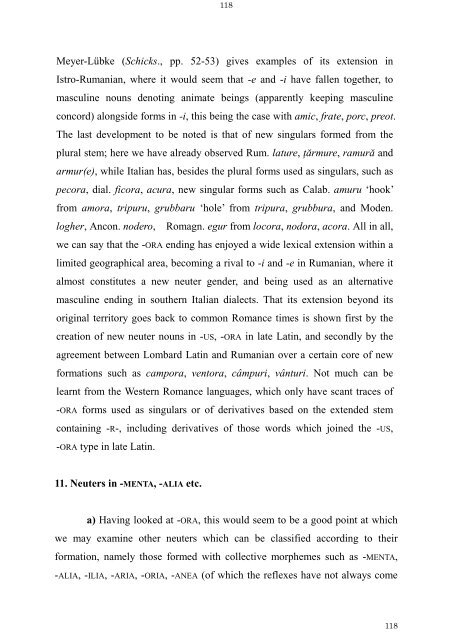The Latin Neuter Plurals in Romance - Page ON
The Latin Neuter Plurals in Romance - Page ON
The Latin Neuter Plurals in Romance - Page ON
Create successful ePaper yourself
Turn your PDF publications into a flip-book with our unique Google optimized e-Paper software.
118<br />
Meyer-Lübke (Schicks., pp. 52-53) gives examples of its extension <strong>in</strong><br />
Istro-Rumanian, where it would seem that -e and -i have fallen together, to<br />
mascul<strong>in</strong>e nouns denot<strong>in</strong>g animate be<strong>in</strong>gs (apparently keep<strong>in</strong>g mascul<strong>in</strong>e<br />
concord) alongside forms <strong>in</strong> -i, this be<strong>in</strong>g the case with amic, frate, porc, preot.<br />
<strong>The</strong> last development to be noted is that of new s<strong>in</strong>gulars formed from the<br />
plural stem; here we have already observed Rum. lature, Ńărmure, ramură and<br />
armur(e), while Italian has, besides the plural forms used as s<strong>in</strong>gulars, such as<br />
pecora, dial. ficora, acura, new s<strong>in</strong>gular forms such as Calab. amuru ‘hook’<br />
from amora, tripuru, grubbaru ‘hole’ from tripura, grubbura, and Moden.<br />
logher, Ancon. nodero, Romagn. egur from locora, nodora, acora. All <strong>in</strong> all,<br />
we can say that the -ORA end<strong>in</strong>g has enjoyed a wide lexical extension with<strong>in</strong> a<br />
limited geographical area, becom<strong>in</strong>g a rival to -i and -e <strong>in</strong> Rumanian, where it<br />
almost constitutes a new neuter gender, and be<strong>in</strong>g used as an alternative<br />
mascul<strong>in</strong>e end<strong>in</strong>g <strong>in</strong> southern Italian dialects. That its extension beyond its<br />
orig<strong>in</strong>al territory goes back to common <strong>Romance</strong> times is shown first by the<br />
creation of new neuter nouns <strong>in</strong> -US, -ORA <strong>in</strong> late <strong>Lat<strong>in</strong></strong>, and secondly by the<br />
agreement between Lombard <strong>Lat<strong>in</strong></strong> and Rumanian over a certa<strong>in</strong> core of new<br />
formations such as campora, ventora, câmpuri, vânturi. Not much can be<br />
learnt from the Western <strong>Romance</strong> languages, which only have scant traces of<br />
-ORA forms used as s<strong>in</strong>gulars or of derivatives based on the extended stem<br />
conta<strong>in</strong><strong>in</strong>g -R-, <strong>in</strong>clud<strong>in</strong>g derivatives of those words which jo<strong>in</strong>ed the -US,<br />
-ORA type <strong>in</strong> late <strong>Lat<strong>in</strong></strong>.<br />
11. <strong>Neuter</strong>s <strong>in</strong> -MENTA, -ALIA etc.<br />
a) Hav<strong>in</strong>g looked at -ORA, this would seem to be a good po<strong>in</strong>t at which<br />
we may exam<strong>in</strong>e other neuters which can be classified accord<strong>in</strong>g to their<br />
formation, namely those formed with collective morphemes such as -MENTA,<br />
-ALIA, -ILIA, -ARIA, -ORIA, -ANEA (of which the reflexes have not always come<br />
118









